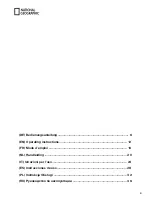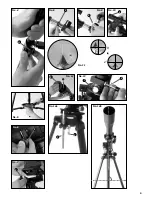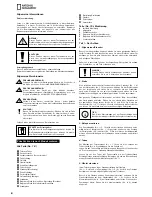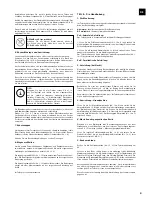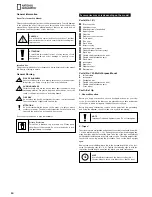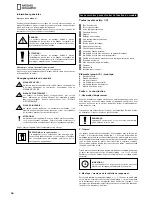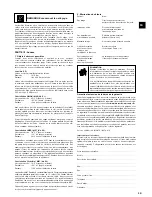
EN
13
3. Accessory Tray
The accessory tray (No. 1 and 3, 10) should be attached to the center of
the tripod brace (No. 1, 16) with the flat side down. The center hole in the
tray should be fitted over the tripod brace retaining fittings. Mount the tray in
place by turning it clockwise 60° (No. 5).
4. Telescope Tube
To mount the telescope tube (No. 1, 1) you undo the screw (No. 6, X) on
the tube ring (No. 1 and 2, 8) and open up the ring. Now you place the
tube in the centre of ring and close the ring up. Now secure the mounting by
tightening the screw. Position the tube, including the ring, with the objective
opening facing north, and place it on the tripod head (No. 1, 9). Fasten the
tube to the tripod head using the clamping screw (No. 7, X).
5. Eyepieces
Three eyepieces (No. 1 and 2, 18) and a diagonal mirror (No. 1 and 2, 19)
are supplied with this telescope. The three eyepieces allow you to decide
which magnification you want for your telescope. Before you insert the eye-
piece and the diagonal mirror, you must remove the dust protection cap from
the eyepiece connection tube (No. 1, 6). Loosen the screw (No. 8, X) on
the eyepiece connection tube and insert the diagonal mirror. Retighten the
screw (No. 8, X) on the eyepiece connection tube.
Repeat the same process on the diagonal mirror screw (No. 9, X) and insert
20 mm eyepiece in the diagonal mirror and retighten.
Make sure that the eyepiece is pointing vertically upward. If it is not, loosen
the screw (No. 8, X) on the eyepiece connection tube and rotate the diago-
nal mirror into the vertical position.
Risk of blindness
Never use this device to look directly at the sun or in the
direct proximity of the sun. Doing so may result in a risk
of blindness.
6. Viewfinder Assembly and Alignment
The viewfinder scope (No. 1 and 2, 2) and its holding device are
preassembled. Push the foot of the viewfinder scope holding device
completely into the base on the telescope tube (No. 10). The holding device
will click into place. Make sure that the viewfinder scope lens (No. 10, X)
faces the barrel opening (No. 1, 4).
There are two black clamping screws on the holding device (No. 1, 3) plus a
silver spring-loaded counter screw. Tighten the black clamping screws until
you feel resistance. This affixes the viewfinder scope barrel in place.
Before you start any observation, it is essential to adjust the viewfinder
scope. The viewfinder scope and main telescope must be positioned identi-
cally in order to make observations with your telescope.
HINT
Insert the 20 mm eyepiece in the diagonal mirror and align
the main telescope with an easily identifiable terrestrial
object (No. 11, A). The object should be at least 200–300
metres away. Position the telescope so that the object
appears in the center of the eyepiece's field of vision. The
image should appear vertical but inverted.
i
Follow the hint above. Once the telescope is aligned, look through the
viewfinder scope. The image should be vertical and not inverted. To align
the viewfinder scope, turn one of the two adjustment screws (No. 1, 3) until
the image appears exactly the way it does through the telescope's eyepiece
(No. 11, B).
To focus the viewfinder scope, turn the viewfinder's front lens barrel (No. 10,
X) left or right until the picture appears sharp and clear.
7. Protection Caps
In order to protect the inside of your telescope from dust and dirt, the barrel
opening (No. 1 and 12, 4) is protected by a dust protection cap (No. 12,
X). Before you begin observing with your telescope, remove the cap from
the opening.
8. Flexible Shafts
To ease precise adjustment of the declination and right ascension axes,
install the flexible shafts (No. 1 and 3, 14 and 15) in the holding devices of
both axes provided for the purpose (No. 13, X and Y).
The long flexible shaft should be mounted parallel to the telescope barrel
(No. 1, 14). Secure it in place with the provided clamping screw in the
axis notch. The short flexible shaft (No. 1, 15) should be mounted laterally.
Secure it in place with the provided clamping screw in the axis notch.
Your telescope is now ready for use.
Part II—Handling
Telescope Mount
Your telescope mount is of a new type that allows you to make two different
types of observations:
A. Azimuth
, ideal for terrestrial use
B. Parallactic
, ideal for celestial observation
A. In azimuth use:
The telescope is moved horizontally and vertically.
1. Undo the polar vertical clamping screw (No. 14a, X) and lower the incline
plate (No. 1, 17; No. 15, B) until it is horizontal (all the way to the stop).
Retighten the polar vertical clamping screw.
2. Undo the vertical clamp (No. 15, A) and move the telescope until it hori-
zontal. Then retighten the vertical clamp. The telescope can now be moved
horizontally and vertically using the flexible shafts (No. 1, 14 and 15; No.
14, D and E).
B. In parallactic use:
2. Night Use
A dark site is very important for observation at night as light interferes with
observation focus and detail visibility.
Allow your eyes to adjust to the darkness after leaving a lighted room. After
about 20 minutes you can begin celestial observation.
Do not use the telescope within an enclosed space. Position your telescope
and accessories in place outside about 30 minutes before observing to
ensure temperature compensation in the telescope tube. Make sure the
telescope is on a flat, stable surface.
3. Alignment—Basic Siting
Undo the polar vertical clamping screw (No. 14a X) and move the incline
plate (No. 1, 17; No. 15, B) to the latitude of your location using the latitude
adjustment rod as a rough guide. Turn the tripod so that the N mark faces
north. The top of the incline plate should also face north (No. 14b). The
latitude adjustment rod (No. 14a, Y) should point south.
4. Setting Latitude
Determine the latitude of your location using a street map, atlas or the
Internet. Germany is between 54° (Flensburg) and 48° (Munich) degrees
of latitude.
Undo the polar vertical clamping screw (No. 14a, X) and move the incline
plate (No. 1, 17; No. 15, B) until the number on the latitude adjustment rod
(No. 14a, Y) matches that of your location.
5. Final Alignment
Turn the declination axis (No. 15, C), including the telescope, 90°.
Place the tube with the correct orientation into the holder and tighten the
clamping screw. The telescope eyepiece should now point to the ground,
and the lens should point to the sky. Undo the polar vertical clamping screw



